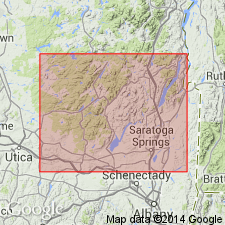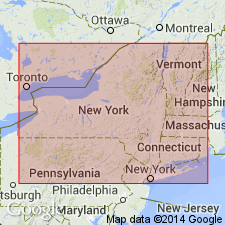
- Usage in publication:
-
- Hoyt limestone member*
- Modifications:
-
- Named
- Dominant lithology:
-
- Limestone
- Dolomite
- AAPG geologic province:
-
- New England province
Summary:
Named Hoyt limestone member of Little Falls dolomite. Unit is basal phase of the Little Falls; occurs locally. Consists of blackish, subcrystalline, pure or only slightly magnesian limestone alternating with beds of blue and light-gray dolomite; quartz sand grains in some of the beds, increasing in amount below; contains many beds of black oolite, most abundant near the base. Fossils include Cryptozoan, trilobites, gastropods, and LINGULEPIS ACUMINATA at many horizons. Thickness is 80 to 120 feet. Gradationally overlies the Potsdam sandstone and underlies the remainder of the Little Falls dolomite. Age is Late Cambrian.
Type locality: exposures at Hoyt's Quarry, 3 miles west of Saratoga Springs, Saratoga Co., eastern NY. Named from Hoyt's Quarry.
Source: Modified from GNU records (USGS DDS-6; Reston GNULEX).

- Usage in publication:
-
- Hoyt limestone
- Modifications:
-
- Revised
- AAPG geologic province:
-
- New England province
Summary:
Cambro-Ordovician correlations revised in Champlain, Hudson, Mohawk, and St. Lawrence Valleys. Revisions involve definitions and successions of previously accepted Cambro-Ordovician formations: Potsdam, Theresa, Hoyt, and Little Falls of Upper Cambrian and Whitehall, Tribes Hill, and Beekmantown of Lower Ordovician. Hoyt fauna occurs in lower half of emended Whitehall formation above Little Falls dolomite. Each revised unit is tied in with the divisions A through E of original "Calciferous" formation (Brainerd and Seely [1891, Amer. Hist. Nat. Hist. Bull., v. 3, p. 1-3]).
Source: US geologic names lexicon (USGS Bull. 1200, p. 1824-1825).

- Usage in publication:
-
- Hoyt limestone member
- Modifications:
-
- Revised
- AAPG geologic province:
-
- New England province
Summary:
Base of Whitehall formation raised to coincide with contact of Little Falls dolomite and Hoyt limestone, and latter is redefined as lower member of Whitehall formation. In corrected Skene Mountain section, Hoyt limestone member, about 40 feet thick, underlies Skene dolomite member (new).
Source: US geologic names lexicon (USGS Bull. 1200, p. 1824-1825).

- Usage in publication:
-
- Hoyt limestone
- Modifications:
-
- Revised
- AAPG geologic province:
-
- Appalachian basin
Summary:
Pg. 795-813. Evidence presented to substantiate radical change in interpretation of Paleozoic stratigraphy of Saratoga Springs region, New York. Previously accepted sequence of beds (Potsdam sandstone, Theresa formation, Hoyt limestone, Little Falls dolomite, Amsterdam limestone, Trenton limestone, Canajoharie shale) is revised to read Potsdam sandstone, Galway formation, Hoyt limestone, Ritchie limestone (new), Mosherville sandstone (new), Gailor dolomite (new), Lowville limestone, Amsterdam limestone, Trenton limestone (Rockland(?), Hull, Sherman Fall representatives) and Canajoharie shale. Term "Theresa" is not applicable in this area; hence, name Galway is reintroduced for strata younger than Potsdam and older than Hoyt. Strata formerly classed as lower Hoyt are here included in redefined Galway. Wheeler (1942) classified the Hoyt as basal member of Whitehall formation and the Skene as upper member, the latter being a very late Late Cambrian offlapping unit. It is evident that he mistook Ordovician Gailor dolomite for older Little Falls dolomite, for the Hoyt and his supposed "Little Falls" are in fault contact in his "unfaulted" area 4 miles west of Saratoga Springs. In some areas Hoyt underlies Mosherville sandstone, and in some areas Ritchie limestone.
Source: US geologic names lexicon (USGS Bull. 1200, p. 1824-1825).
For more information, please contact Nancy Stamm, Geologic Names Committee Secretary.
Asterisk (*) indicates published by U.S. Geological Survey authors.
"No current usage" (†) implies that a name has been abandoned or has fallen into disuse. Former usage and, if known, replacement name given in parentheses ( ).
Slash (/) indicates name conflicts with nomenclatural guidelines (CSN, 1933; ACSN, 1961, 1970; NACSN, 1983, 2005, 2021). May be explained within brackets ([ ]).

